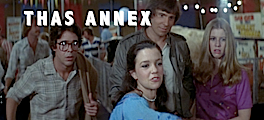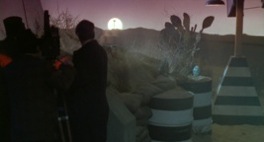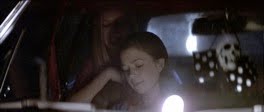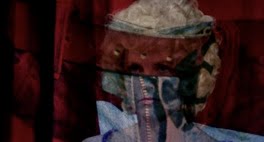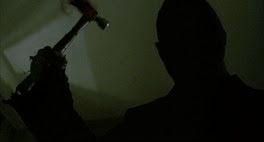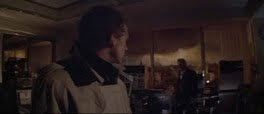For this post I present
not one of my favorite scenes from Hooper's catalog. To think
Eaten Alive goes from one of its most striking, articulate scenes - all that occurs within the Starlight's one motel room holding the dysfunctional family of three, herded peremptorily into it by unforeseen crisis - to the abject "bathroom scene" that lingers on Marilyn Burns as she divests herself of both her garments and her airs.
It becomes clear how, forthwith, with predilection, I've stacked the deck in favor of Hooper as my chosen Great Artist: all circumstantial insider tidbits I may have appear, clear as day to me, as currying favor, in favor, for the film (and its artistic good sense, its maturity) and Hooper's careful choices (always). This scene, the bathroom scene, I have decided is no less than integral, a miraculous appropriation of meaning in an abject scene of typically no meaning. I have decided it is integral whether or not it was a scene directed or designed by Hooper, or whether it was a scene instead futzed-over by a de facto director stand-in during one of Hooper's reported walk-outs.
(The only reason I suggest such an idea is for the fact that Hooper is said to have not been on set during the filming of the moment where Neville Brand corners Marilyn Burns before effectively "kidnapping" her - I can only assume the entire set-piece of Judd attacking Fay, and thus her bathroom scene, were filmed in close conjunction, but of course we can never know for sure the convolutions of a film's shooting schedule).
But, if it was filmed by Hooper, it is a rather base scene of rudimentary camera movements (utilizing a single, unbroken take) simply following and panning along with her actions around the tiny washroom - no bout of florid camera or visual design sees light of day in this scene. If it was filmed by someone else, it still exists as a part of the overall make-up of
Eaten Alive, which, regardless, always carries some mark of Hooper's "vision" of things - the creation of a studio-bound, dark
Wizard of Oz which he set out to make, scenes always bathed in expressionistic lighting; a film that moves deliberately through a series of intimate scenes - of many scenes alone - with each character in an ensemble of characters, marking out their own personal existences and their own personal dramas.
I was watching Andre de Toth's 1957
Monkey on My Back, about a self-destructive boxer inclined to addiction - the same de Toth who would, in his late years, be somehow brought in to cameo in Hooper's
Spontaneous Combustion as the SHC expert of the film's prologue. I noticed, in
Monkey on My Back, the attention De Toth would give to staging an intimate scene as a series of small movements made by the characters, small shifts of blocking given either their own emphatic frame or emphasized with a camera movement. It is an old-fashioned way of creating cinematic drama through an almost lingual camera "editorializing," parsing out character motions and dramatic staging through the "building" - almost in a "stacking" sense - of superfluous cinematic frames. It is an old-fashioned film language that De Toth personally seems to retool, to his auteurist claim-staking, in a way that it enhances the sense of intimacy: the deliberate fabricating of character movements and the attendant re-framings, deliberate and proliferate, in effect stretches out time. A languorous temporal dimension is thus created from this visual
studying of the movements of characters, whilst caught up in the melodramatic exchanges typical of that era. It was while watching De Toth, cinema
persona grata in
Spontaneous Combustion, that I realized the importance of all the maxims and philosophies of "slow cinema" - film storytelling that does not prioritize visual design as a narrative relaying device, but as a way to inhabit temporality, a sense of time that buggers the notion of film craft as inherently narrative and all things narratively motivating.
Eaten Alive's "base," "lecherous" bathroom scene - that at once seems like both the leer of grindhouse's laziest impetuses and the unwavering attention to a woman casting off all camouflage and veneer - is a stretching of time that almost seems to reinforce its feminist importance through its lack of cinematic dressing. Hooper does this again later in
Eaten Alive with Libby's undressing scene, he performs this in half-measure with Amy's shower scene in
The Funhouse and Diane Freeling's molestation scene (following long, languid bath scene) in
Poltergeist (a suddenly offensive and objectionable display acted upon a character we have been identifying as our hero), he does it with Stretch in
Texas Chainsaw Massacre 2, molested in cut-offs she is never made to don off for they are essentially her skin (the way Lefty's uniform is essentially his skin: battle raiment for both), and it is an act he does through the vessel of an entire film in
Night Terrors. Let's face it, Hooper's interest in female characters is an interest in imbuing them with reality and character (in the many senses of the word) in the face of a genre that often finds its purpose in demeaning them.
The bathroom scene, despite its laziness, despite the possibility Hooper was not on set to direct it to his vision, fits into
Eaten Alive's MO of finding the exact right moments to spend alone with its characters, isolated in their own personal existences (Judd, of course, more than any).
Fay (Marilyn Burns)'s tiredness and frustration come through in her movements more than anything else.
She throws down her second peeled off stocking with contempt.
She peels off her jacket and folds it, sets it down, pats it, with at least some remaining patience and pride for her dirty, oppressive, wifely ornaments.
She checks the door, making sure of her privacy.
The skirt comes off.
The blouse unbuttons.
And she finally gets in.




















































































